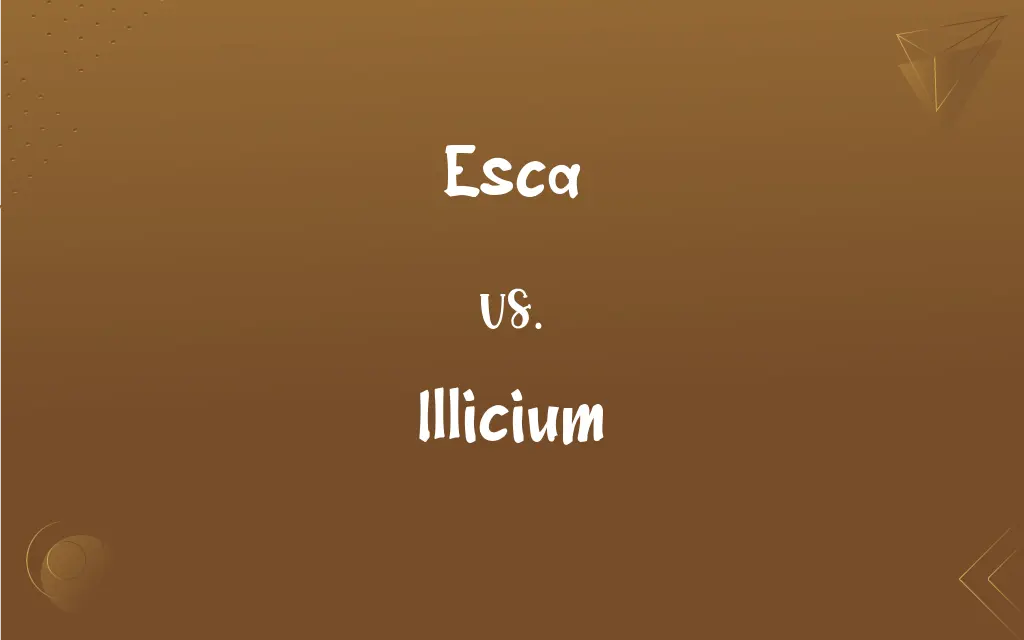Esca vs. Illicium: What's the Difference?
Edited by Harlon Moss || By Janet White || Published on March 26, 2024
Esca is the bioluminescent lure used by anglerfish to attract prey, while illicium is the rod-like structure from which the esca hangs.

Key Differences
Esca and illicium are anatomical features found in anglerfish, a group of marine fish known for their unique method of predation. The esca is the bioluminescent lure that anglerfish use to attract prey in the dark depths of the ocean. It is located at the end of the illicium, which is a rod-like extension that protrudes from the fish's head. The illicium, on the other hand, serves as the support structure for the esca. It is a modified dorsal fin spine that can vary in length among different species of anglerfish. The illicium allows the anglerfish to move the esca in a way that mimics the movements of small marine organisms, further enhancing its ability to attract prey.
The esca is primarily associated with its bioluminescent function, the illicium's main purpose is structural. However, both the esca and the illicium are essential for the anglerfish's hunting strategy. Without the illicium, the esca would not be able to be presented effectively to potential prey, and without the esca, the illicium would lack its primary function as a fishing lure.
The esca and illicium are complementary structures that work together to enable anglerfish to hunt effectively in the deep sea. The esca provides the light and visual attraction, while the illicium offers the necessary support and movement to make the lure enticing to prey.
Comparison Chart
Function
Bioluminescent lure for attracting prey
Support structure for the esca
Location
At the end of the illicium
Protrudes from the fish's head
ADVERTISEMENT
Composition
Often contains bioluminescent bacteria
Modified dorsal fin spine
Role in Predation
Provides visual attraction
Provides movement and positioning
Variability
Can vary in brightness and color
Can vary in length and flexibility
Esca and Illicium Definitions
Esca
A bioluminescent lure used by anglerfish to attract prey in the deep sea.
The anglerfish's esca glowed brightly, attracting small fish towards its waiting jaws.
Illicium
The rod-like structure in anglerfish that supports the bioluminescent esca.
The anglerfish extended its illicium, positioning the esca to attract prey.
ADVERTISEMENT
Esca
The tip of the anglerfish's fishing rod-like appendage, used for enticing prey.
The fish adjusted the position of its esca to better attract the attention of nearby prey.
Illicium
A modified dorsal fin spine in anglerfish, used to dangle the esca.
The length of the illicium varies among anglerfish species, affecting how they present their esca.
Esca
A key feature in the anglerfish's hunting strategy, providing visual lure in the dark ocean depths.
The effectiveness of the anglerfish's hunting relies heavily on the allure of its brightly glowing esca.
Illicium
A crucial part of the anglerfish's anatomy, enabling the movement of the esca.
The flexibility of the illicium allows the anglerfish to move its esca in a lifelike manner.
Esca
The light-emitting organ at the end of an anglerfish's illicium.
The esca's glow mimicked the appearance of a small marine creature, luring in the predator's next meal.
Illicium
The appendage that allows anglerfish to manipulate the position of their lure.
The anglerfish twitched its illicium, making the esca dance enticingly in the water.
Esca
A specialized structure in anglerfish that harbors symbiotic bioluminescent bacteria.
The esca's bioluminescence is a result of a symbiotic relationship with bacteria that produce light.
Illicium
The structural component of the anglerfish's lure system, essential for effective predation.
Without a sturdy illicium, the anglerfish would struggle to properly use its esca.
Esca
(ichthyology) The fleshy growth from an anglerfish's head that acts as a lure for its prey.
Illicium
(ichthyology) The modified dorsal fin on the head of anglerfish, acting as a lure.
Esca
(phytopathology) A fungal disease afflicting grapes.
Illicium
A genus of Asiatic and American magnoliaceous trees, having star-shaped fruit; star anise. The fruit of Illicium anisatum is used as a spice in India, and its oil is largely used in Europe for flavoring cordials, being almost identical with true oil of anise.
Esca
A traditional Galician unit of dry measure, equivalent to about 6–9 L depending on the substance measured.
Illicium
Anise trees: evergreen trees with aromatic leaves
Esca
A kind of measuring cup once used for measuring escas of grain.
FAQs
Are the esca and illicium found in all anglerfish?
Most anglerfish species have an esca and illicium, but their size and appearance can vary.
What is the illicium?
The illicium is a rod-like structure in anglerfish that supports the bioluminescent esca.
What is the esca?
The esca is a bioluminescent lure used by anglerfish to attract prey in the deep sea.
What is the role of the illicium in predation?
The illicium positions and moves the esca to make it more enticing to potential prey.
How does the esca attract prey?
The esca attracts prey by emitting light and mimicking the appearance of small marine organisms.
How do anglerfish acquire their bioluminescent bacteria?
Anglerfish acquire bioluminescent bacteria from the environment, which then colonize the esca.
Can the brightness of the esca vary?
Yes, the brightness and color of the esca can vary depending on the species and the presence of symbiotic bacteria.
Is the illicium always straight?
The illicium can vary in length and flexibility, and it may not always be straight.
How does the esca contribute to the anglerfish's camouflage?
The esca helps the anglerfish blend into its environment by providing a distraction that draws attention away from the rest of its body.
How do anglerfish control their esca?
Anglerfish control their esca through movements of the illicium and by regulating the light emitted by the esca.
Do all anglerfish use their esca for hunting?
While most anglerfish use their esca for hunting, some species may use it for other purposes, such as attracting mates.
How long is the illicium in comparison to the anglerfish's body?
The length of the illicium varies among species and can range from a small fraction of the body length to almost equaling it.
Do all deep-sea fish have an esca and illicium?
No, the esca and illicium are specific to anglerfish and a few other related species.
Can the illicium be used to measure the size of an anglerfish?
While the illicium can give an indication of size, it is not a reliable measure of the overall size of an anglerfish.
Can the illicium be retracted?
In some anglerfish species, the illicium can be retracted or folded down when not in use.
Can the color of the esca change?
The color of the esca can vary depending on the species and the specific symbiotic bacteria present.
What happens if an anglerfish's esca is damaged?
If an anglerfish's esca is damaged, it may affect its ability to attract prey effectively.
Is the illicium used for any purpose other than supporting the esca?
The primary function of the illicium is to support and manipulate the esca, but it may also play a role in mating displays in some species.
Are there any predators that target the esca or illicium?
Predators may target the esca or illicium if they mistake it for prey, but these structures are not typically a primary target.
How does the structure of the esca and illicium vary among different anglerfish species?
The structure of the esca and illicium can vary significantly among different anglerfish species, with differences in size, shape, and flexibility.
About Author
Written by
Janet WhiteJanet White has been an esteemed writer and blogger for Difference Wiki. Holding a Master's degree in Science and Medical Journalism from the prestigious Boston University, she has consistently demonstrated her expertise and passion for her field. When she's not immersed in her work, Janet relishes her time exercising, delving into a good book, and cherishing moments with friends and family.
Edited by
Harlon MossHarlon is a seasoned quality moderator and accomplished content writer for Difference Wiki. An alumnus of the prestigious University of California, he earned his degree in Computer Science. Leveraging his academic background, Harlon brings a meticulous and informed perspective to his work, ensuring content accuracy and excellence.































































